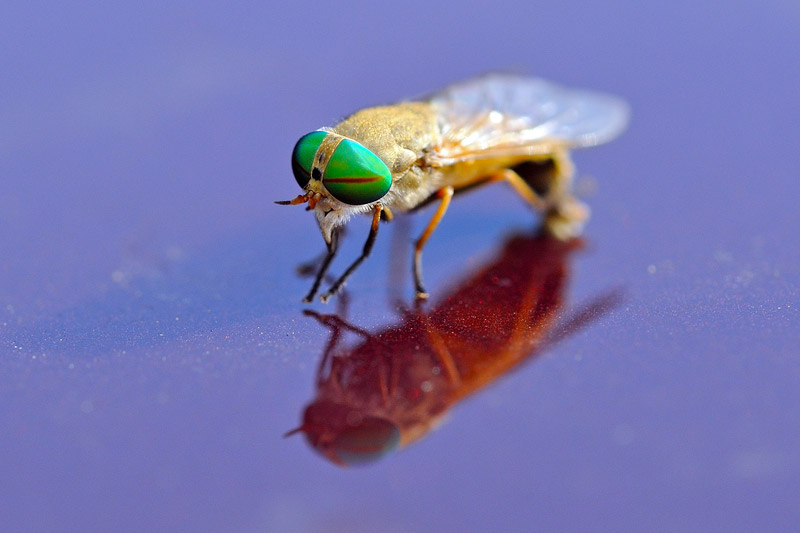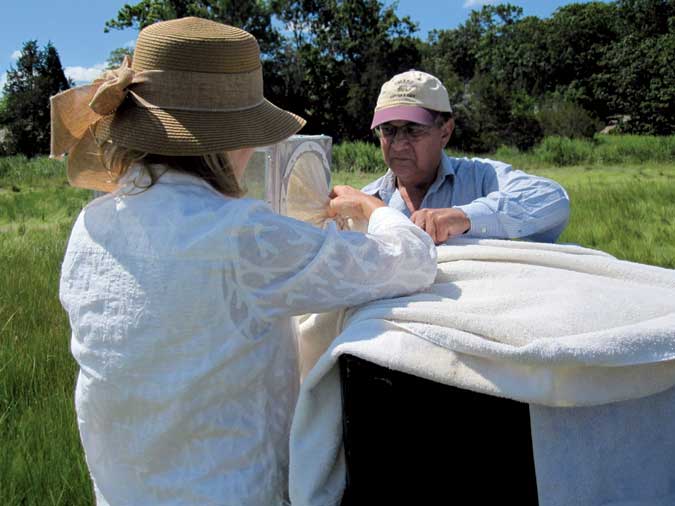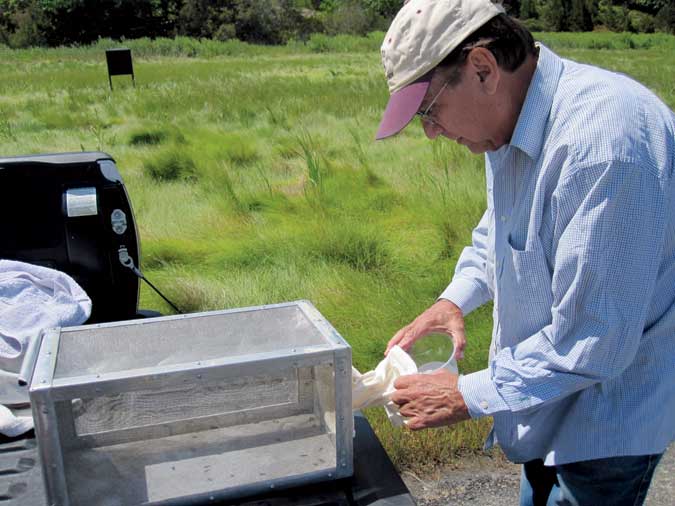Beasts of the Northern Wild | All About Greenhead Flies
Come mid-July, greenhead flies descend upon the beaches of New England. Learn more about these fierce, hungry, bloodsucking flies.

Closeup photo of a greenhead horsefly.
Greenhead flies, named for their large, bright green eyes, can be found in the coastal marshes of Eastern North America. Unfortunately for us, that means they love New England’s beaches. Knowing about these pests can help you plan your next beach trip the safe way — away from the painful bites of greenhead flies.
The wild serenity of the salt marsh stretches from Maine to Florida. It is a world caught between worlds, a lovely transitional swath of emerald grass that snakes along the Atlantic coastline, occupying a territory somewhere between sea and solid ground.
This line of demarcation between solid and liquid is neither and both. The ground of the salt marsh is springy, like walking on a lumpy trampoline. Water oozes up through tufts of matted grass, potholes lurk beneath seemingly solid ground.
Who inhabits this spongy world? Apart from the occasional deer, there are turtles, assorted birds, mice, and, once in a while, a rabbit, a raccoon, or an otter, mostly just passing through. Which means it’s slim pickings for one small, hungry inhabitant, whose appetite revs into high gear ’round about mid-July.
Like ripening fruit at the moment of perfection, Tabanus nigrovittatus emerges from the salt marsh at summer’s midpoint. She has just laid her first batch of eggs. Two hundred or so microscopic dots, but who’s counting, because right now she’s out of her mind with hunger, and it’s time to get down to the business at hand. Her first blood meal. Ever. In her young adult life she’s never had a solid meal, subsisting mostly on nectar, preferring to wait until the whole egg-laying business is behind her. By doing so, she ensures that the precious bloodline will continue, that the next generation of greenhead flies–as she is more commonly known–will be born. But right now she’s paying the price. And there’s not a thing to eat.
A stone’s throw from the unearthly beauty of the salt marsh, some of the great New England beaches sprawl beside the Atlantic, baking in the sun: Crane Beach, in Ipswich; Plum Island, off the coast of northeastern Massachusetts; Hammonasset Beach, unfurling along the Connecticut side of Long Island Sound. A brilliant blue sky stretches overhead; a faint breeze ruffles the grasses. Perfect beach weather. A great day to fly. Her dazzling green eyes casting about, she makes a beeline for the water. The sand up ahead is swarming with warm, scantily clothed bodies, fairly bursting with reservoirs of succulent human blood.
“Greenheads,” says the blond boy barricaded in the entrance booth at Hammonasset Beach State Park. He slides open a window and points to a squashed bug taped to the side of the building. “They’re pretty bad today. You may want to think about it.”
Given the size and spread of the flattened insect, “pretty bad” seems like a PR understatement. The little torpedo is more than half as long as my thumb, and even mashed up it’s easy to imagine hordes of greenhead flies making for the beach like vacationers racing to claim their patch of sand. Like most beachgoers, tabanids prefer warm, sunny days, and it is, of course, an especially beautiful July morning, without even a hint of breeze. The sun is already fierce, the distant sand shimmers with promise, and the sea is as blue as the Aegean.
But a face-off with greenhead flies? Their size makes them fairly immune to bug repellent, and slathering on DEET isn’t a very appealing option. Do I want to spend a day swatting these things? I squint at this poster child for a bad day at the beach, weighing the pros and cons. In full knowledge that at this very moment, a similar scenario is playing out, up and down the East Coast. Cars backing up, just as I’m about to do, turning around and heading home. Or at the very least, somewhere far from the coastal salt marshes.
And that’s when I get curious.
What’s up with this bug? Clearly it’s a robust type of horsefly (the name is a tip-off), and it certainly outweighs its relative the deerfly, although both biters belong to the same fly family, Tabanidae. And “greenhead” obviously refers to its enormous green eyes, laced with bands of iridescent red or purple.
But above and beyond these physical characteristics, and the fact that greenhead flies will indiscriminately attack horses, cows, dogs, hogs, and deer, this fly is notorious mainly for one thing: the pain it inflicts in large numbers on beachgoers at the height of summer. Make that two things, because like The Terminator, this fly is relentless. It will not stop until someone pays the price.
Stories of encounters with greenheads have a dramatic quality usually reserved for plays written by one-name ancient Greeks. But the blunt truth is that these creatures can ruin a day, or days, at the beach.
Often during peak greenhead season–generally early or mid-July to mid-August–beaches will post warnings about fly conditions, like some weird variation on the surf report. At Crane Beach there’s another sign, too: No Refunds. But it’s not about singling out one beach or another; any gathering spot near a salt marsh–beach, restaurant, or home–is potentially vulnerable. Sometimes it’s just a matter of degree.
“All salt marshes on Cape Cod provide habitat for greenhead flies,” says Gabrielle Sakolsky, entomologist and assistant superintendent at the Cape Cod Mosquito Control Project. “Our largest marshes, adjacent to the large barrier beaches of Sandy Neck and Nauset, are the worst, because they have the largest amount of larval habitat. There are no immune spots.”
If that’s the case, I suddenly have more questions. Can greenheads be outsmarted? What makes them so rabid in the first place? Why is the pain so fierce? And don’t we have any options?
In search of answers, I’ve found myself knee-deep in a salt marsh with John Stoffolano, Ph.D., professor of entomology at UMass Amherst. It’s early August: prime tabanid time.

Photo Credit : Annie Graves
Every summer, Dr. Stoffolano and his students head into the dark heart of greenhead territory–the broad and glorious salt marshes that spread out around Pine Island, in Newbury, Massachusetts, not far from Crane Beach. Here they collect thousands of flies from the shiny black wooden boxes that stagger on slender legs across the marsh, like dark, square animals imagined by a Cubist carpenter. Back at UMass, they conduct research on greenhead behavior and physiology. “We’re the only ones doing this kind of work,” Dr. Stoffolano told me when I first visited his office in Amherst, months earlier. “At one time there was a lot of interest.”
That was before scientists learned that tabanids do not in fact carry Lyme disease or AIDS, that they’re merely a horrible nuisance. But in the 30-plus years he’s been researching these greenhead flies, Dr. Stoffolano has learned a lot, and he’s got the office to prove it. Bookshelves overflow with the chaos of his profession–research materials, scientific papers (many his own), and reference books–the contents spilling onto the floor, the desktop, any available surface.
In sharp contrast to its occupant, who is neat, self-contained, and, it turns out, pretty funny, with an adventurous streak. Tales of tsetse flies in South Africa, encounters with biting beach flies in the Seychelles, and experiences at a Zulu healing ceremony weave in and around talk of greenhead flies. His mother is part Mohawk Indian, and Dr. Stoffolano’s interest in indigenous cultures and insects has gradually evolved into a college course on cultural entomology, in which he uses insects to teach diversity, while incorporating references to art, music, mythology, and archaeology. Traces of Indiana Jones, minus the bullwhip.
Over the next few hours, I get a crash course in greenhead flies: Tabanids 101, if you will. For instance, I learn that the males don’t bite. Only the female is out for blood, but when she first takes flight, she’s actually a vegetarian. It’s a little like hearing that sharks prefer salad. (The seeds of bloodlust are sown early, though; the larvae are carnivorous and cannibalistic, and if there’s nothing else handy, like an earthworm or some other type of larva, they’ll eat each other.)
“Before she’s laid her eggs, you can even let her take a walk on you,” Dr. Stoffolano insists. “When the males and females emerge from the pupa stage, they feed on carbohydrates, like nectar or honeydew, for energy, for flight. That’s their gasoline. But once the female lays her eggs, her whole behavior changes. She becomes extremely aggressive. In this second cycle she’s seeking a host–cow, deer, human. She needs to have a blood meal if she’s going to lay another batch of eggs.”
Then he shows me the photos. And now I understand why it hurts.
Unlike the delicate mosquito, which is a vessel or capillary feeder, drawing blood much like a syringe does, tabanids are pool feeders, meaning they sever lots of capillaries at once, in order to create a gaping wound so that the blood can pour out. Close-ups of the greenhead’s tiny mandibles reveal an unsettling similarity to a pair of deadly, razor-sharp scissors, able to slice through skin like a knife through mayo. Tiny temperature receptors on the insect’s antennae have already detected whether or not the host is warm-blooded. Now that she’s attached, two other mouthparts pull her head deeper and deeper. She’ll keep on sucking until you smack her away. Then she’ll come back for more. Over and over and over.
At first, according to Dr. Stoffolano, it doesn’t hurt. “I’ve watched them go all the way down into my hand,” he says matter-of-factly. “They probe the skin for temperature, then they pierce the skin, and then they salivate. The saliva contains an anticoagulant so that the blood doesn’t clot. As soon as they release saliva, which is a foreign protein, our bodies react to it and we sense pain. That’s when we swat ’em.”
Pain is the greenhead’s great enemy. The very thing she does so well keeps her forever hungry: The viciousness of her bite practically guarantees that it will be difficult for this insect to get a good meal. But here’s where Nature’s brilliant adaptability comes through, letting the greenhead make the best of a bad deal.
“There’s not a lot of blood out on the salt marsh,” Dr. Stoffolano says. “They probably never get a good blood meal. So they’ve evolved a strategy of being able to lay the first egg batch without taking a blood meal. And that’s one of the major problems in controlling this fly. You’ve seen all the traps, right?” I nod my head. Anyone who’s driven the East Coast during the summer months can’t miss the black boxes strewn about the salt marshes up and down the Atlantic. “All those females that go into the traps have already laid a batch of eggs first. So you’re not cutting down on the population. What you’re cutting down on is the biting frequency and the nuisance factor. The traps are nuisance control.”
Which is still better than nothing, he acknowledges. Greenhead adults live three to four weeks, so the population builds up. They’re strong fliers, too, so if they can’t find a meal at the beach, they’ll fly a couple of miles inland. And although on a good day a greenhead can lay up to 200 eggs in what may be her first and last reproductive act, these dark, heavy traps–painted black to mimic large animals, like cows–can attract and capture up to 1,000 greenheads per hour. That’s good news for beachgoers, boaters, and anyone who lives nearby.
Frankly, short of spraying the entire East Coast, there aren’t a lot of other options. The insects themselves are too big to eliminate without using massive amounts of pesticides, which would damage the delicate salt-marsh habitat. Besides, greenhead flies play a couple of important roles within that fragile ecosystem. First, as an indicator of marsh health. And second, as a food source: Their spring larvae are consumed by shorebirds and fish, while adult greenhead flies are protein for purple martins and tree swallows. Eat or be eaten.
“The other problem we face with these greenheads is the vastness of the salt marsh,” Dr. Stoffolano adds. “It goes from Texas all the way around Florida, all the way up the East Coast, up into Nova Scotia. It’s a huge area. How do you control such a vast area?”
Meanwhile, I’m about to visit my first trap. I’m wading through thigh-high grass with Dr. Stoffolano and his wife, Susan, headed toward one of the greenhead traps alongside the road that cuts through the marsh around Pine Island. I’m wearing light-colored clothing, because greenhead flies zero in on dark, moving objects, and I’m covered head to toe, despite the blazing heat. We approach the first black box–it’s buzzing audibly.
“That’s a sound you don’t want to hear,” Susan Stoffolano observes, as we peer through the thick screen on the top of the box, reinforced so that birds can’t tear it apart to get at the insects. Inside, the box is crawling with tabanids, and two interior troughs are littered with corpses. There’s no bait; the insects enter from below, fly up to the light, and then can’t figure out how to exit. (The Northeast Massachusetts Mosquito Control & Wetlands Management District installs and maintains the boxes, but lets Dr. Stoffolano remove greenhead flies as needed.)
Together, he and his wife unscrew a corner of the trap, drape towels over sections to direct the flow of insects, and position a mesh carrier over the opening. Low-tech, but it works. It quickly fills with live flies, and we move on to the next trap. A steady breeze blows, keeping us mostly fly free.
Listening to all this buzz reminds me of a story Dr. Stoffolano told me about how horses were once used on the marsh around Pine Island to help cut salt-marsh hay, which even today is prized by gardeners for inhibiting weeds: “They made nets out of ropes that completely covered the horse, so that as the horse moved, it would dislodge any tabanids that were trying to bite.” And even in modern times, rumor has it that sometimes the postmen around Newbury and Pine Island will balk at delivering the mail, because greenhead flies are attracted to the moving mail truck and get trapped inside with its unlucky driver.
So what’s a human to do? I ask the horsefly expert for any words of wisdom, recommendations, last-minute thoughts.
“If it’s the season of the fly in your area, you gotta wear light-colored, protective clothing,” he replies. “They can’t bite through your clothes. And I would suggest that more beaches post Web sites. If it’s a heavy day for greenheads, don’t show up at the beach; you’re wasting your money. Forget about it. If you’re a restaurant, and you don’t want people sitting outside to be bitten, then you put traps up.”
His hand flashes before me, and with a graceful swipe he captures a renegade greenhead, crawling on top of the trap. “They’re beautiful creatures, aren’t they?” he smiles. He’s gripping the insect in a sort of tiny Heimlich maneuver, so that it can’t bite him, and then he holds it up to my face for a closer look. I’m staring into a pair of huge (relatively speaking) green eyes. “Look at those eyes,” he marvels, and then releases it.
Two hundred more eggs, if she gets a solid meal, I think to myself. And we watch her fly away.
Has your vacation ever been impacted by greenhead flies? Tell us about it!
Annie Graves
A New Hampshire native, Annie has been a writer and editor for over 25 years, while also composing music and writing young adult novels.
More by Annie Graves





